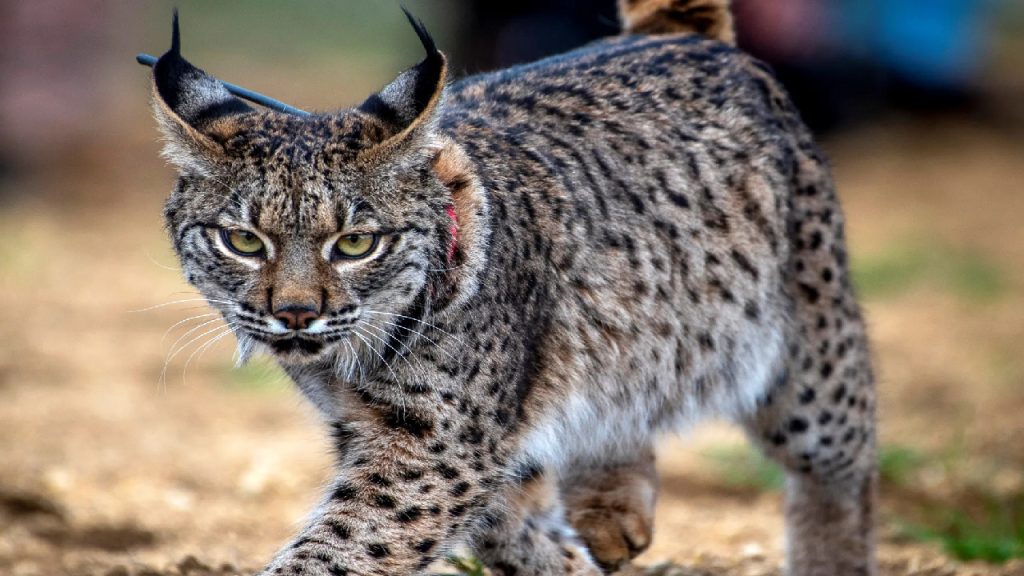The Iberian lynx is heavily spotted and weighs about half as much as the Eurasian species, with long legs and a very short tail with a black tip. Its coat is tawny with dark spots and it bears a characteristic “beard” around its face and prominent black ear tufts. It Weighs: 10-13kg and its
Height is 88-100cm.
The Iberian lynx mostly depends on wild rabbits to feed, but it will also eat ducks, young deer and partridges if rabbit densities are low. While an adult lynx needs about one rabbit a day, a mother raising her young needs to catch about 3.
Female lynxes generally give birth between March and April. The average litter size is 3, with rarely more than 2 young surviving weaning. Kittens leave the den between 8 and 23 months. Very high rates of mortality during dispersal have been detected.
One of the world’s rarest cats, the Iberian lynx, is no longer classed as endangered, according to a report by the International Union for Conservation of Nature (IUCN).
Its population grew from 62 mature individuals in 2001 to 648 in 2022. While young and mature lynx combined now have an estimated population of more than 2,000, the IUCN reports.
In the early 19th century the Iberian lynx was found in Spain, Portugal and Southern France. It declined steadily during the 20th century, and at the beginning of the 2000s only two isolated breeding populations remained in the world, located in southern Spain, and totaling about 100 adult animals, with only 25 breeding females.
But after joint efforts of the Spanish national and regional administrations, different NGOs (like WWF) and the European Union (via the Life projects), the species has recovered from the brink of extinction. IUCN’s assessment in 2015 has downgraded the Iberian Lynx to “endangered”, due to the increase in mature individuals from 2002.
The 2014 census shows 327 individuals in the strongholds of the species in Andalucia, and since the summer of 2014 around 50 lynxes have been introduced in the LIFE Iberlince reintroduction areas: Sierra Morena and Montes de Toledo in Castilla-La Mancha (Spain), the Matachel Valley in Extremadura (Spain), and Guadiana Valley in Portugal.
The reintroduced lynxes come from the Iberian Lynx Ex-situ Conservation Programme, which is still running and contributing to the future of this endangered species: 53 cubs were born in 2015.
As the name suggests, the wild cat species calls the Iberian region – Spain and Portugal – home.
Iberian lynx require variable terrain below 1300 m, containing a mosaic of closed Mediterranean scrubland interspersed with open patches of grassland, often with marsh ecotones. This natural mosaic landscape creates the optimal balance of shrub cover and open space. Lynx use areas of scrubland as shelter as well as for bedding and breeding. Areas with minimal cover provide habitat for their primary prey, European rabbits (Oryctolagus cuniculus), which occur in higher densities in these locations. Unfortunately, Iberian lynx have disappeared from many areas containing suitable habitat, presumably due to low rabbit densities. (Delibes, et al., 2000; Ferreras, et al., 2004; Pedro Sarmento, et al., 2008)
And the latest 2015 census shows 404 adult lynxes.
Despite these signs of hope, crucial challenges remain unsolved, and the species future is still fragile.
Ironically, in the past the species was regarded both as an attractive hunting trophy and as a vermin. Hunters prized its valuable fur and its meat, and although some landowners appreciate its tendency to keep fox and rabbit numbers down, most perceive it as a threat to their game populations. The Iberian lynx was legally protected against hunting from the early 1970s, but they are still the victims of guns, traps and snares, particularly those set for other animals.

